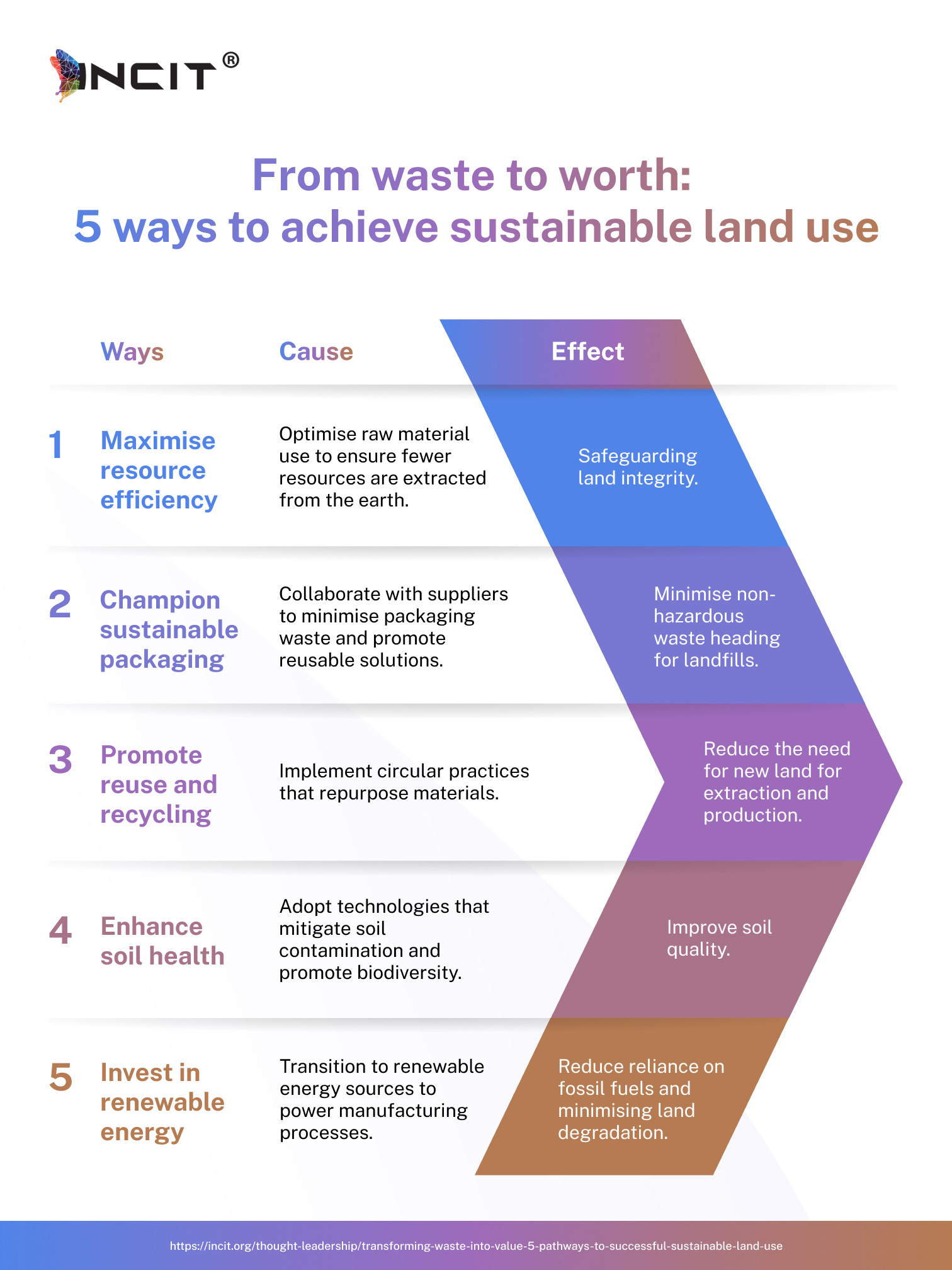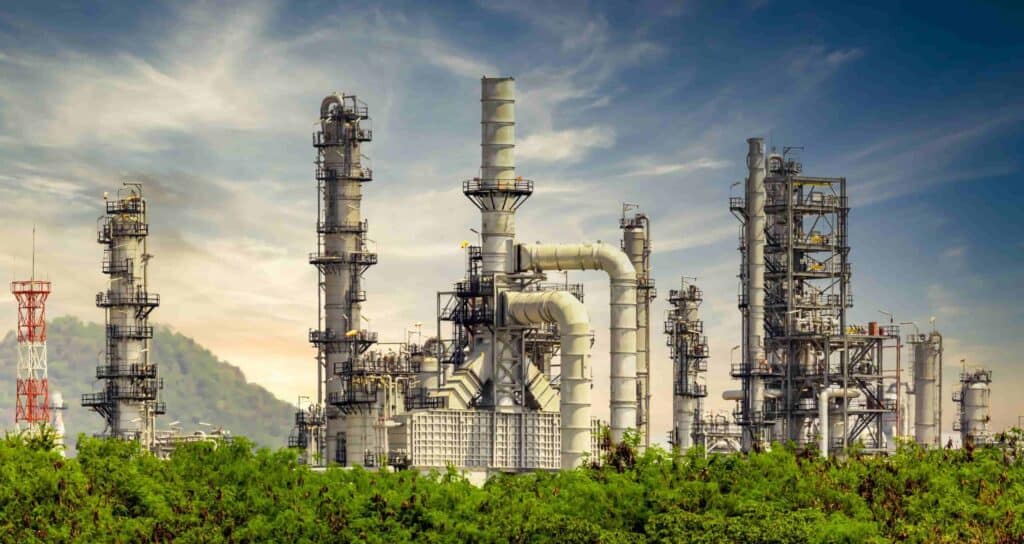Pembuatan adalah salah satu sumber pencemaran terbesar di seluruh dunia, dan ini tidak mungkin berubah kerana permintaan pengguna terhadap produk terus berkembang. Proses perindustrian, terutamanya dalam perlombongan dan pembuatan, secara sejarahnya telah menjadi penyumbang utama kepada pencemaran tanah, dan penggunaan bahan kimia—tidak termasuk farmaseutikal—diunjurkan meningkat sebanyak 85 peratus menjelang 2030. Walau bagaimanapun, pengilang tidak boleh terbiar apabila melibatkan tindakan iklim. Mereka mesti mengambil peranan aktif dalam mengurangkan sisa dan menggalakkan penggunaan tanah yang mampan. Dengan mengurangkan sisa, komuniti lebih dilindungi dan tidak terjejas secara negatif oleh perusahaan yang menerajui peningkatan kesihatan alam sekitar kawasan itu dengan aktiviti yang mengurangkan pencemaran dan memelihara ekosistem semula jadi.
Bagaimanakah pengeluar boleh mengambil peranan utama? Pertama, mereka boleh mengurangkan jejak ekologi mereka dan menggunakan tanah secara mampan dengan mengurangkan sisa, bermula dengan kitar semula, pengkomposan dan penggunaan yang bertanggungjawab. Menurut McKinsey & Co., dunia memerlukan tambahan 70-80 juta hektar tanah untuk memenuhi keperluan manusia untuk makanan dan bahan bakar. Dari mana datangnya tanah yang boleh dihuni ini? Walaupun ini adalah masalah untuk semua orang, pengilang mesti bertindak pantas untuk mewujudkan asas yang kukuh untuk kegunaan tanah yang mampan tidak lama lagi dan menetapkan penanda aras untuk diikuti oleh sektor lain.
Berikut ialah cara anda boleh mengguna pakai teknik pembuatan hijau dan menerima prinsip ekonomi bulat, seperti meminimumkan sisa, menggalakkan penggunaan semula produk dan mengoptimumkan kecekapan sumber untuk pendekatan pengurusan tanah dan penjanaan semula tanah yang lebih bertanggungjawab.

Untuk melaksanakan amalan ini dengan berkesan, bersandar pada Indeks Kesediaan Industri Kelestarian Pengguna (COSIRI), rangka kerja yang diiktiraf secara meluas untuk menilai kematangan kemampanan merentas bidang utama seperti tingkat kedai, rantaian bekalan, logistik, strategi dan risiko. Ia menyediakan CEO dengan pandangan penting untuk membuat keputusan strategik, mempromosikan amalan mampan dalam operasi. Bersedia untuk membuat impak perniagaan yang ketara? Terokai lebih lanjut tentang cara INCIT boleh bertindak sebagai panduan pakar anda, menyokong organisasi anda ke arah operasi yang lebih mampan yang menghasilkan amalan penggunaan tanah yang lebih baik oleh menghubungi kami.
Soalan Lazim Mengenai Strategi Penggunaan Tanah Mampan dalam Pembuatan
Apakah Penggunaan Tanah Mampan dalam Pembuatan?
Penggunaan tanah yang mampan dalam pembuatan melibatkan perancangan dan pengurusan tanah perindustrian untuk meminimumkan kesan alam sekitar, mengurangkan sisa, dan menggalakkan kecekapan sumber jangka panjang sambil menyokong pertumbuhan ekonomi dan kesejahteraan masyarakat.
Bagaimanakah Sisa Boleh Diubah Menjadi Nilai dalam Guna Tanah Perindustrian?
Sisa boleh diubah menjadi nilai dalam penggunaan tanah perindustrian dengan menggunakan semula bahan, menebus semula tapak brownfield, menggunakan produk sampingan untuk tenaga atau pembinaan, dan menyepadukan prinsip ekonomi bulat ke dalam pembangunan tapak.
Apakah Faedah Penggunaan Tanah Mampan untuk Pengilang?
Penggunaan tanah yang mampan membantu pengilang mengurangkan risiko alam sekitar, mengurangkan kos operasi, meningkatkan pematuhan piawaian ESG, meningkatkan reputasi jenama dan membuka kunci hasil baharu melalui inovasi buangan kepada nilai.
Bagaimanakah Perancangan Guna Tanah Menyokong Kelestarian Alam Sekitar?
Perancangan guna tanah menyokong kelestarian alam sekitar dengan mengurangkan gangguan habitat, mengurus sumber dengan cekap, mencegah pencemaran tanah dan air, dan membolehkan penggunaan semula tapak perindustrian sedia ada.
Apakah Peranan Ekonomi Pekeliling dalam Guna Tanah Mampan?
Ekonomi bulat memainkan peranan penting dalam penggunaan tanah yang mampan dengan menggalakkan penggunaan semula bahan, meminimumkan sisa, dan menggalakkan sistem gelung tertutup di mana tanah, sumber dan infrastruktur dioptimumkan untuk kegunaan jangka panjang.
Apakah Contoh Strategi Sisa kepada Nilai dalam Pembuatan?
Contohnya termasuk menggunakan produk sampingan pembuatan untuk penjanaan tenaga, menukar sisa industri kepada bahan mentah untuk proses lain dan menuntut semula tanah untuk ruang hijau atau pemasangan tenaga boleh diperbaharui.
Bagaimanakah Tapak Brownfield Boleh Diguna Semula untuk Penggunaan Mampan?
Tapak Brownfield boleh digunakan semula melalui pemulihan tanah, naik taraf infrastruktur, dan penyepaduan prinsip reka bentuk mampan, menukar tanah yang tidak digunakan atau tercemar kepada aset perindustrian atau komuniti yang produktif, mesra alam.
Bagaimanakah Penggunaan Tanah Mampan Menyumbang kepada Matlamat Esg?
Penggunaan tanah yang mampan menyumbang kepada matlamat ESG dengan mengurangkan kesan alam sekitar (E), menyokong komuniti tempatan melalui pembangunan yang bertanggungjawab (S), dan menyelaraskan pengurusan tanah dengan amalan tadbir urus yang telus (G).
Apakah Cabaran Yang Dihadapi Syarikat dalam Melaksanakan Strategi Guna Tanah Mampan?
Cabaran termasuk kos pemulihan yang tinggi, kerumitan peraturan, kekurangan kepakaran teknikal, rintangan pihak berkepentingan, dan akses terhad kepada bahan mampan atau pilihan pembiayaan untuk pembangunan semula tapak.


